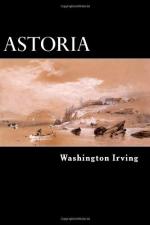At one place the shores seemed absolutely lined with buffaloes; many were making their way across the stream, snorting, and blowing, and floundering. Numbers, in spite of every effort, were borne by the rapid current within shot of the boats, and several were killed. At another place a number were descried on the beach of a small island, under the shade of the trees, or standing in the water, like cattle, to avoid the flies and the heat of the day.
Several of the best marksmen stationed themselves in the bow of a barge which advanced slowly and silently, stemming the current with the aid of a broad sail and a fair breeze. The buffaloes stood gazing quietly at the barge as it approached, perfectly unconscious of their danger. The fattest of the herd was selected by the hunters, who all fired together and brought down their victim.
Besides the buffaloes they saw abundance of deer, and frequent gangs of stately elks, together with light troops of sprightly antelopes, the fleetest and most beautiful inhabitants of the prairies.
There are two kinds of antelopes in these regions, one nearly the size of the common deer, the other not much larger than a goat. Their color is a light gray, or rather dun, slightly spotted with white; and they have small horns like those of the deer, which they never shed. Nothing can surpass the delicate and elegant finish of their limbs, in which lightness, elasticity, and strength are wonderfully combined. All the attitudes and movements of this beautiful animal are graceful and picturesque; and it is altogether as fit a subject for the fanciful uses of the poet as the oft-sung gazelle of the East.
Their habits are shy and capricious; they keep on the open plains, are quick to take the alarm, and bound away with a fleetness that defies pursuit. When thus skimming across a prairie in the autumn, their light gray or dun color blends with the hue of the withered herbage, the swiftness of their motion baffles the eye, and they almost seem unsubstantial forms, driven like gossamer before the wind.
While they thus keep to the open plain and trust to their speed, they are safe; but they have a prurient curiosity that sometimes betrays them to their ruin. When they have scud for some distance and left their pursuer behind, they will suddenly stop and turn to gaze at the object of their alarm. If the pursuit is not followed up they will, after a time, yield to their inquisitive hankering, and return to the place from whence they have been frightened.
John Day, the veteran hunter already mentioned, displayed his experience and skill in entrapping one of these beautiful animals. Taking advantage of its well known curiosity, he laid down flat among the grass, and putting his handkerchief on the end of his ramrod, waved it gently in the air. This had the effect of the fabled fascination of the rattlesnake. The antelope approached timidly, pausing and reconnoitering with increased curiosity; moving round the point of attraction in a circle, but still drawing nearer and nearer, until being within range of the deadly rifle, he fell a victim to his curiosity.




